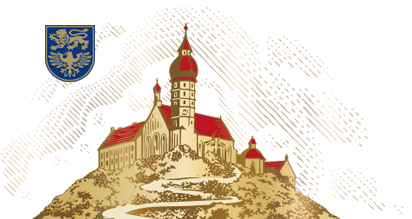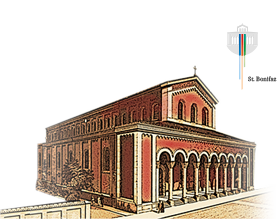Rise and decline
An initial period of growth begins with the founding of the monastery in 1455. But the dawn of a new era soon follows. Although the monastery is hard pressed by the Reformation and Thirty Years’ War, nobody considers giving up the Holy Mountain of Bavaria.
After its founding in 1455, the monastery initially flourishes. This period is marked by donations and construction projects.
The Holy Chapel is sanctified in 1472. In 1492, the monks of Andechs elect their first abbot from their own ranks: Johann von Schrattenbach (1492-1521). The first relic altar is built in 1494.
Yet Andechs is not left unscathed by the general decline of the church starting in 1520. Effects of the Reformation are felt. The number of pilgrims begins to decline. This is in part due to the criticism of pilgrimage, but also the Peasant Wars. Monastery discipline begins to decrease as well and economic conditions become more difficult. Four administrators and five abbots try to improve the situation from 1540 to 1588 – albeit without success.
Abbot David Aichler (1588-1596) from Ottobeuren is first able to stabilise the situation. He tightens up monastery discipline, publishes an Andechs chronicle in 1595 and acquires new furnishings for the church. The Vöhlin Chapel is built during this period (1591-1594). The southern church square is constructed in 1593 as a place for pilgrims to gather. Here they can come together when the Andechs relics are displayed from the jutty of the Vöhlin Chapel during what is known as the presentation of the relics. This is also where the southern church square got its name, Fronhof, or Herrenhof in German. The name refers to the relics of Christ shown during the presentation of the relics, such as a particle of the cross or a piece of the crown of thorns.
Another boom begins with the election of Abbot Johann Chrysostomus Huttler (1600-1610). In 1607 the Pilgrimage Church is redesigned in the Renaissance style. The period of prosperity continues under Abbot Michael Einslin (1610-1640). Around 100,000 pilgrims come to Andechs each year during this time. The Holy Mountain is once again at the centre of church life in Bavaria.
Thirty Years’ War and reconstruction
The ravages of the Thirty Years’ War (1618-1648) are all the worse. Billeting, looting, the plague, flight and displacement define the years described by Abbot Maurus Friesenegger (1640-1655) in his famous journal. But with the end of the war, the monastery’s recovery was comparatively rapid, until lightning struck the top of the tower in 1669. Except for the Holy Chapel and the guest wing, the church and monastery were reduced to rubble and ash. Yet the church was re-roofed before the end of 1669 and the monastery was occupied again in 1671. Under Abbot Maurus Rambeck (1666-1686), the Bavarian Benedictine Congregation was established in 1683 with major contributions by Andechs abbots and monks. The water supply on the Holy Mountain was considerably improved in 1687 with the construction of the first water line.




